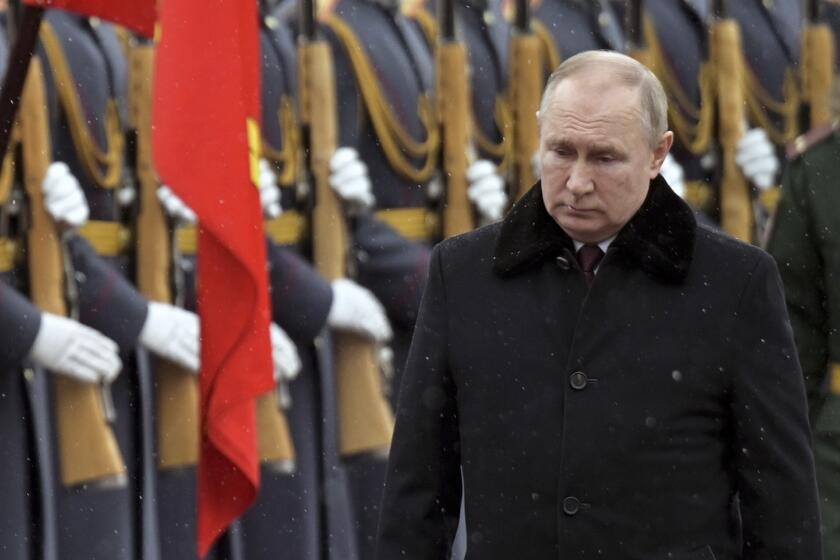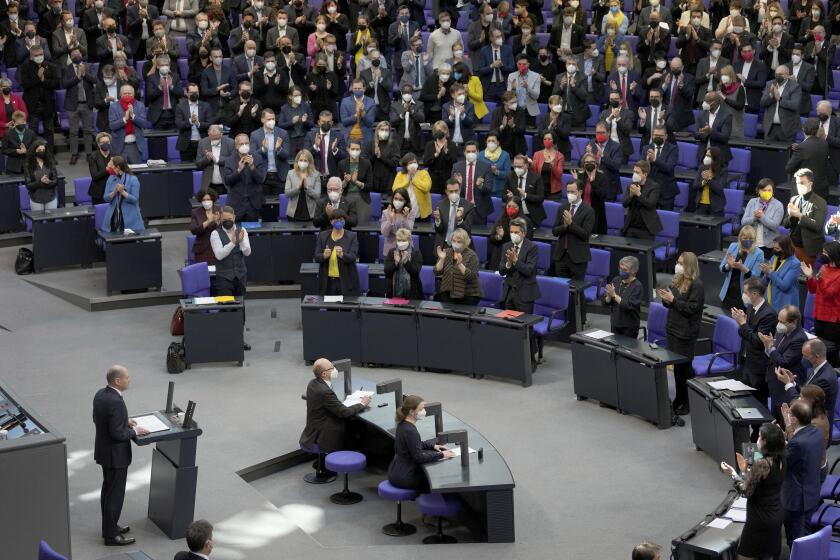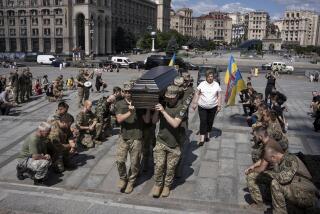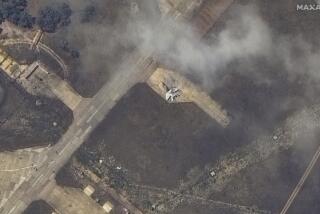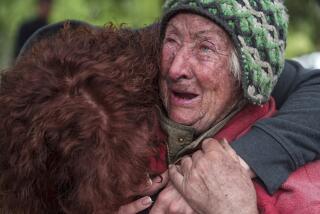NATO rejects Ukraine’s plea for no-fly zone after Russia seizes nuclear plant, uses cluster bombs
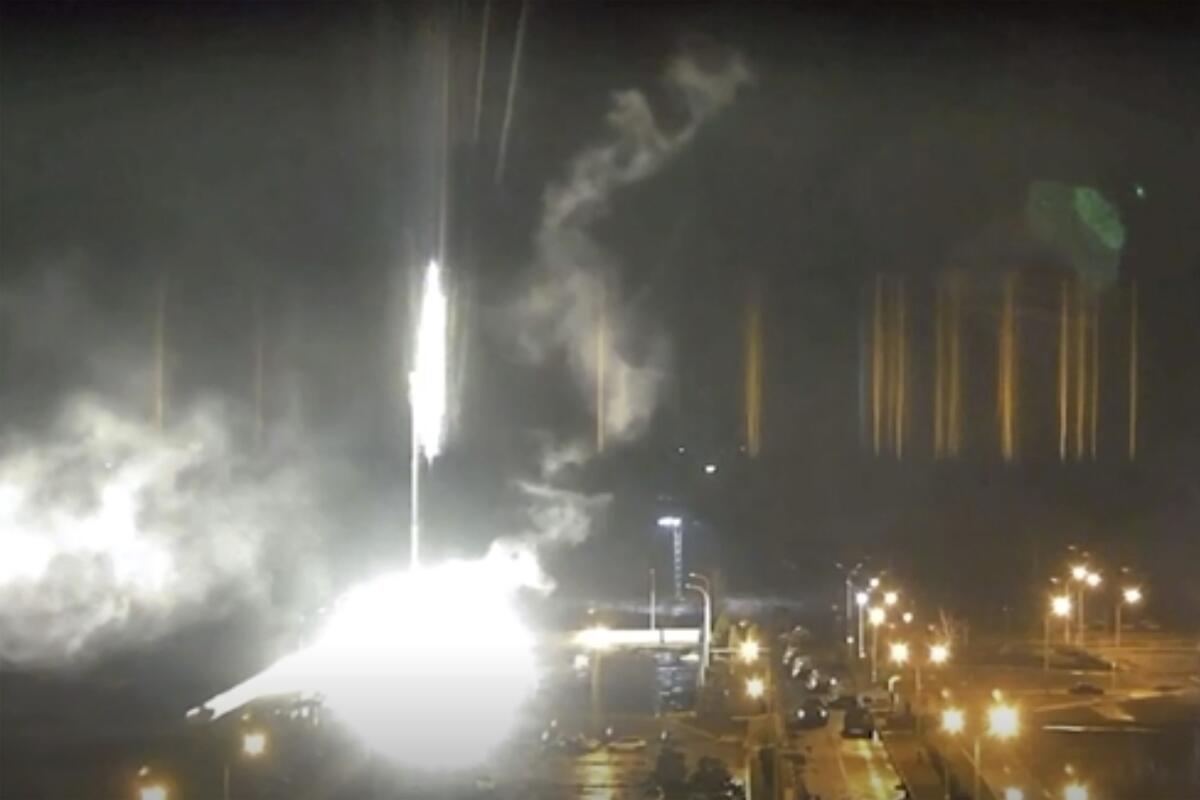
- Share via
KYIV, Ukraine — Russian forces pressed their offensive against key Ukrainian cities Friday in a heavy bombing and shelling campaign that has led to a ballooning humanitarian disaster, spurred a growing exodus of people and raised fears of a wider calamity after Europe’s biggest nuclear power plant was set ablaze.
A chorus of international condemnation and outrage followed Moscow’s capture of the nuclear complex, amid indications Russian forces would continue to go after such facilities.
And in Ukraine’s south, Russian troops besieged the city of Mykolaiv in an apparent march toward Odessa, Ukraine’s most important city on the Black Sea.
In urgent meetings of U.S. and European leaders at NATO headquarters in Brussels, the alliance’s commander confirmed Russia was attacking Ukrainians with cluster bombs, a munition outlawed by more than 120 countries. But NATO also rejected Ukraine’s pleas to establish a no-fly zone over the battered country.
“Unfortunately, tragically, horrifically, this may not be over soon,” U.S. Secretary of State Antony J. Blinken said, emerging grim-faced from the meetings.
Blinken said a no-fly zone would require employing NATO aircraft over Ukraine in potential conflict with Russian fighter jets and lead to “a full-fledged war in Europe.”
The Biden administration, which has joined most of Europe in enacting severe economic sanctions on Russia, said it was examining a ban on Russian oil exports, although support for that is muted because it would raise gas prices in the U.S. and Europe.
Pentagon officials expressed alarm over Russia’s violent takeover of the Zaporizhzhia nuclear complex in the southeastern city of Enerhodar and said it remains unclear how Moscow plans to use the facility. At a minimum, the Russians could cut off the electricity that the plant supplies to much of Ukraine, a senior official said.
“Using combat power to try to take a nuclear power plant over ... it just underscores the recklessness of this Russian invasion,” the official said, briefing reporters in Washington on condition of anonymity.
Authorities said Friday morning that local firefighters had extinguished the fire at the plant and that there had been no release of radioactive material. Even with Russian forces in control, officials said, the local staff continues to operate the plant and is inspecting it for damage.
None of the site’s six reactors — only one of which was in use, at about 60% capacity — was damaged, said Rafael Mariano Grossi, the head of the International Atomic Energy Agency in Geneva. Initial reports Friday had mistakenly indicated there was a fire inside one of the reactors.
But the strike on the plant, which sparked immediate fears of a Chernobyl-like disaster, with radioactive clouds drifting over the rest of Europe, demonstrated anew the war’s potential for terrifying effects far outside Ukraine’s borders. Norway’s leader called the shelling of Zaporizhzhia “in line with madness.”
Linda Thomas-Greenfield, the U.S. ambassador to the United Nations, warned in an emergency session of the Security Council that Russia could make use of any of Ukraine’s other nuclear facilities as pawns in the war.
Energoatom, Ukraine’s state nuclear plant operator, said three Ukrainian soldiers were killed and two were injured in the strike.
In an emotional video address, Ukrainian President Volodymyr Zelensky appealed for a stop to the shelling of Zaporizhzhia and for a Western-enforced no-fly zone over the country to forestall any other strikes on sensitive infrastructure. Ukraine is home to four nuclear power plants.
“Only urgent action by Europe can stop the Russian troops,” said Zelensky, who fielded a flurry of worried calls from President Biden and other world leaders. “Do not allow the death of Europe from a catastrophe at a nuclear power station.”
His comments came as Russian troops strengthened their grip on Ukraine’s south in a bid to choke off access to the Black and Azov seas and establish control over a swath of land pushing up against Moldova and NATO member Romania to the west. The city of Kherson has fallen, and the strategic port of Mariupol has come under constant shelling, with hundreds of residents feared dead, basic services disrupted and supplies cut off.
The mayor of Mykolaiv, northwest of Kherson, said Friday that his city remained under Ukrainian control “for now.”
“Russian troops are on the outskirts of the city,” Mayor Oleksandr Senkevych said in a telephone interview with The Times. The troops had pressed north from the Crimean peninsula that Russia illegally annexed eight years ago.
“They destroyed people’s homes, schools and other civilian infrastructure,” the mayor said.
The Ukrainian military and local civilian defense forces were holding them at bay, Senkevych said. But it was unclear how long the resistance could be sustained and whether, if overrun, the city would be able to feed or protect its people.
“I am determined to resist to the last bullet,” he said. “I am with my city. I am with my people.”
An advisor to Zelensky said Ukrainian forces had also repelled an assault on the strategic port city of Odessa, the Associated Press reported. Shelling continued in Kyiv, the capital, and Kharkiv, the nation’s second-most populous city, in the northeast.
The United Nations says 1.3 million people — about 3% of Ukraine’s population — have fled the country in the last nine days. Thousands of refugees are reportedly arriving by the hour in neighboring Poland and Hungary.
Life for LGBTQ people in Ukraine had been improving, while Russian President Vladimir Putin has systematically attacked gay and transgender people.
On Friday, the U.N. Human Rights Council voted to investigate allegations of Russian abuses in Ukraine, following a similar move by prosecutors at the International Criminal Court at The Hague.
Russian President Vladimir Putin, who launched the invasion of Ukraine, which he calls a “special military operation,” on Feb. 24, denies that his troops have targeted civilians. The Kremlin, without providing evidence, has accused Ukrainian forces of using residents as human shields.
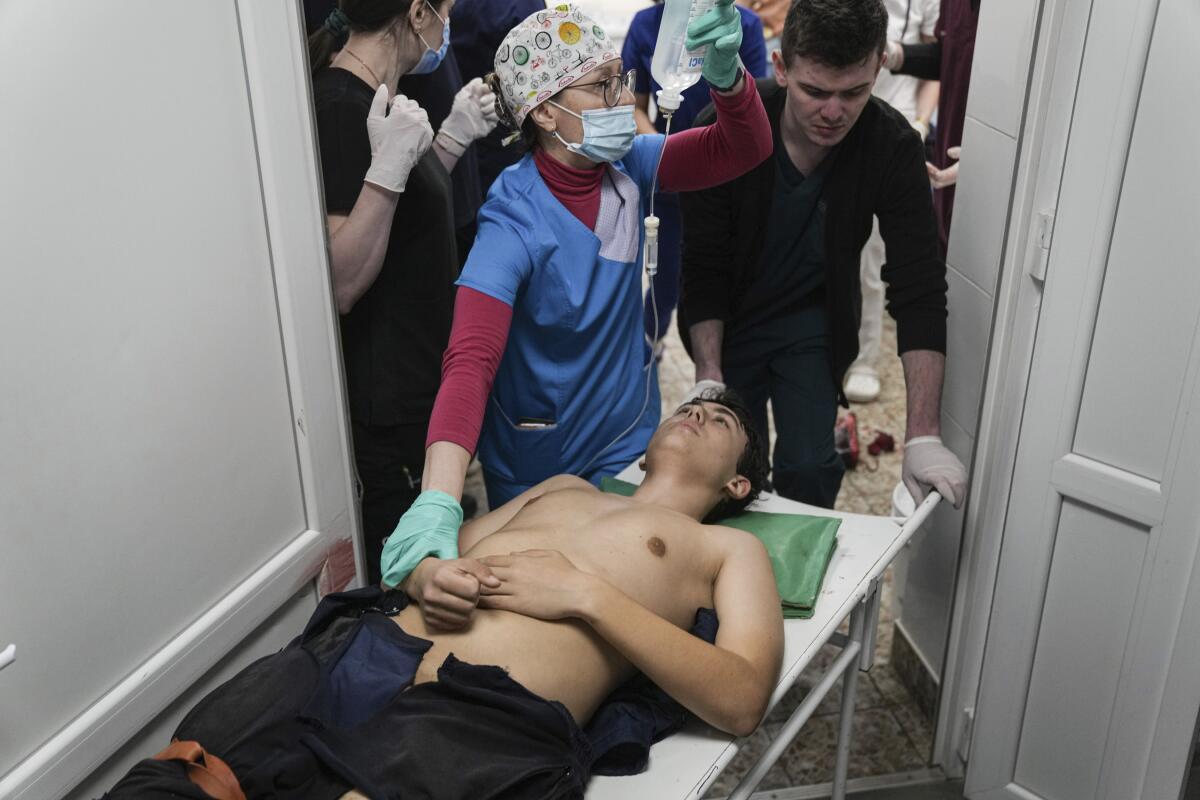
North Atlantic Treaty Organization Secretary-General Jens Stoltenberg said the attack on Zaporizhzhia showed “the recklessness of this war.” At the same time, he said, NATO would not deploy planes over Ukrainian airspace to establish a no-fly zone or put troops on the ground in Ukraine, in order to avoid a greater confrontation with Moscow.
Stoltenberg confirmed Russia’s use of cluster bombs — a potential war crime because the bombs are made of numerous smaller explosives that are indiscriminate in whom they kill and maim. Neither Russia nor the U.S. signed onto the international convention that bans the munition, nor has Ukraine. But Ukraine has already stated an eagerness to cooperate with the International Criminal Court, which is investigating potential war crimes by Russia even though Kyiv is not a signatory to that body, either.
“We call on President Putin to stop this war immediately, withdraw all his forces from Ukraine without conditions and engage in genuine diplomacy now,” Stoltenberg said.
Blinken echoed that demand, saying that Putin’s “war of choice” undermined the fundamental principles of self-determination and democracy.
“If we allow those principles to be challenged, as Putin’s doing now, with impunity, that will open a Pandora’s box of trouble for not just us but, quite frankly, for the entire world,” Blinken said.
The Russian president is believed to be very wealthy, but his assets are in the name of relatives, associates and friendly oligarchs.
But the possibility of a Russian pullback is remote. After a 90-minute call between Putin and French President Emmanuel Macron on Thursday, an aide to Macron warned that the Russian leader insisted he would see the invasion through to the end. And on Friday, Putin told German Chancellor Olaf Scholz that Russia would consider cease-fire talks if Kyiv recognized Moscow’s sovereignty over Crimea and the occupied swaths of eastern Ukraine, according to a Kremlin readout of the conversation.
“The days to come are likely to be worse, with more death, more suffering and more destruction as Russian armed forces bring in heavier weaponry and continue their attacks across the country,” Stoltenberg said.
A small gleam of hope emerged after talks Thursday between Russian and Ukrainian representatives, who tentatively agreed on the setup of specially designated corridors where temporary cease-fires would be called and residents could escape the fighting safely.
In Kyiv, traffic stretched for miles Friday morning on the city’s southern outskirts as people tried to leave before an expected full-scale Russian onslaught. In the northwestern suburbs, the sound of explosions was frequent — testament to the proximity of enemy combatants. And nightfall was heralded with a major blast that shook buildings in the center of the capital.
Russian President Vladimir Putin’s assault on Ukraine is turning his fears of a more resolute Europe and NATO alliance into a self-fulfilling prophecy.
For days, a column of Russian armored vehicles 40 miles long has sat north of Kyiv, threatening a massive incursion or an attempted blockade, but its progress has been slow, beset by logistical missteps, Western intelligence officials say.
Fierce resistance by Ukrainian forces has also helped keep the Russians at bay in Kyiv and other major population centers. On Friday, Defense Minister Oleksii Reznikov said the Ukrainian navy had destroyed its own flagship, which was undergoing repairs, to prevent it from being seized and used by Russian forces.
The commander of the frigate Hetman Sahaidachny took the decision to flood the ship, Reznikov said on Facebook, adding: “It is hard to imagine a more difficult decision for a courageous soldier and crew.”
Zelensky said Friday that 9,200 Russian troops had been killed since the invasion began, but the figure could not be independently verified. More than 2,000 Ukrainian civilians have perished, the government said.
Breaking News
Get breaking news, investigations, analysis and more signature journalism from the Los Angeles Times in your inbox.
You may occasionally receive promotional content from the Los Angeles Times.
In a rare admission of casualties, the Kremlin earlier this week acknowledged the deaths of about 500 Russian soldiers. But Putin has told his people that the war is going according to plan, and the government’s grip on the media has meant that few Russians have seen reports or footage of the death and destruction being visited on Ukraine or their own forces.
A number of independent news outlets have closed down in recent days, and the remaining Russian media have parroted the official line that the “special military operation” has mostly been confined to eastern Ukraine, as protection for the large population of Russian speakers there, and that the overall goal is to disarm and “denazify” Ukraine’s leadership, even though Zelensky is Jewish.
On Friday, Russian news agencies reported that the lower house of the Russian parliament had approved a bill to make the spreading of “fake” information about the invasion punishable by up to 15 years in prison. The British news service BBC announced it was suspending operations in Russia for the time being.
Bulos reported from Kyiv, Chu from London and Wilkinson from Washington. Times staff writers Anumita Kaur and Eli Stokols in Washington contributed to this report.
More to Read
Sign up for Essential California
The most important California stories and recommendations in your inbox every morning.
You may occasionally receive promotional content from the Los Angeles Times.

